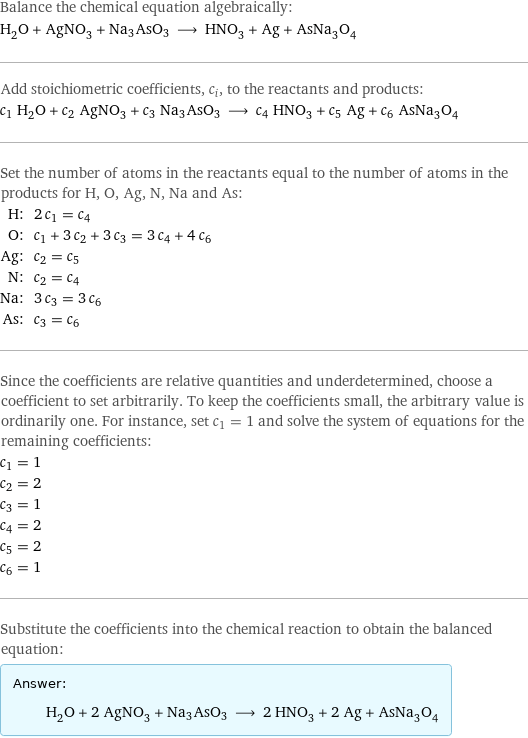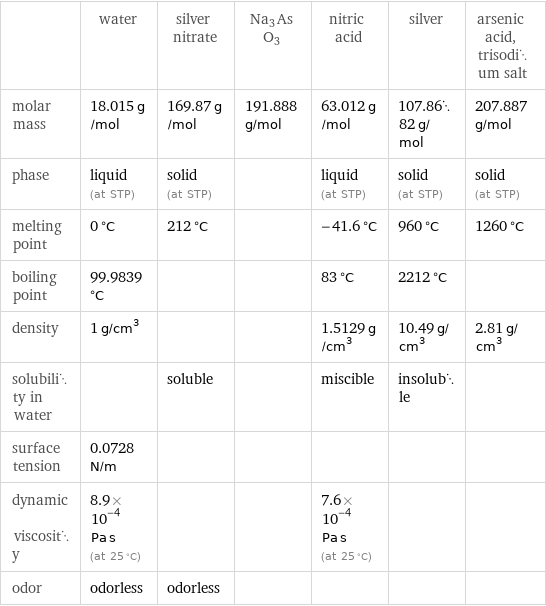Input interpretation

H_2O water + AgNO_3 silver nitrate + Na3AsO3 ⟶ HNO_3 nitric acid + Ag silver + AsNa_3O_4 arsenic acid, trisodium salt
Balanced equation

Balance the chemical equation algebraically: H_2O + AgNO_3 + Na3AsO3 ⟶ HNO_3 + Ag + AsNa_3O_4 Add stoichiometric coefficients, c_i, to the reactants and products: c_1 H_2O + c_2 AgNO_3 + c_3 Na3AsO3 ⟶ c_4 HNO_3 + c_5 Ag + c_6 AsNa_3O_4 Set the number of atoms in the reactants equal to the number of atoms in the products for H, O, Ag, N, Na and As: H: | 2 c_1 = c_4 O: | c_1 + 3 c_2 + 3 c_3 = 3 c_4 + 4 c_6 Ag: | c_2 = c_5 N: | c_2 = c_4 Na: | 3 c_3 = 3 c_6 As: | c_3 = c_6 Since the coefficients are relative quantities and underdetermined, choose a coefficient to set arbitrarily. To keep the coefficients small, the arbitrary value is ordinarily one. For instance, set c_1 = 1 and solve the system of equations for the remaining coefficients: c_1 = 1 c_2 = 2 c_3 = 1 c_4 = 2 c_5 = 2 c_6 = 1 Substitute the coefficients into the chemical reaction to obtain the balanced equation: Answer: | | H_2O + 2 AgNO_3 + Na3AsO3 ⟶ 2 HNO_3 + 2 Ag + AsNa_3O_4
Structures

+ + Na3AsO3 ⟶ + +
Names

water + silver nitrate + Na3AsO3 ⟶ nitric acid + silver + arsenic acid, trisodium salt
Equilibrium constant
![Construct the equilibrium constant, K, expression for: H_2O + AgNO_3 + Na3AsO3 ⟶ HNO_3 + Ag + AsNa_3O_4 Plan: • Balance the chemical equation. • Determine the stoichiometric numbers. • Assemble the activity expression for each chemical species. • Use the activity expressions to build the equilibrium constant expression. Write the balanced chemical equation: H_2O + 2 AgNO_3 + Na3AsO3 ⟶ 2 HNO_3 + 2 Ag + AsNa_3O_4 Assign stoichiometric numbers, ν_i, using the stoichiometric coefficients, c_i, from the balanced chemical equation in the following manner: ν_i = -c_i for reactants and ν_i = c_i for products: chemical species | c_i | ν_i H_2O | 1 | -1 AgNO_3 | 2 | -2 Na3AsO3 | 1 | -1 HNO_3 | 2 | 2 Ag | 2 | 2 AsNa_3O_4 | 1 | 1 Assemble the activity expressions accounting for the state of matter and ν_i: chemical species | c_i | ν_i | activity expression H_2O | 1 | -1 | ([H2O])^(-1) AgNO_3 | 2 | -2 | ([AgNO3])^(-2) Na3AsO3 | 1 | -1 | ([Na3AsO3])^(-1) HNO_3 | 2 | 2 | ([HNO3])^2 Ag | 2 | 2 | ([Ag])^2 AsNa_3O_4 | 1 | 1 | [AsNa3O4] The equilibrium constant symbol in the concentration basis is: K_c Mulitply the activity expressions to arrive at the K_c expression: Answer: | | K_c = ([H2O])^(-1) ([AgNO3])^(-2) ([Na3AsO3])^(-1) ([HNO3])^2 ([Ag])^2 [AsNa3O4] = (([HNO3])^2 ([Ag])^2 [AsNa3O4])/([H2O] ([AgNO3])^2 [Na3AsO3])](../image_source/0f63fdbf922de046b37042a96cda0ea6.png)
Construct the equilibrium constant, K, expression for: H_2O + AgNO_3 + Na3AsO3 ⟶ HNO_3 + Ag + AsNa_3O_4 Plan: • Balance the chemical equation. • Determine the stoichiometric numbers. • Assemble the activity expression for each chemical species. • Use the activity expressions to build the equilibrium constant expression. Write the balanced chemical equation: H_2O + 2 AgNO_3 + Na3AsO3 ⟶ 2 HNO_3 + 2 Ag + AsNa_3O_4 Assign stoichiometric numbers, ν_i, using the stoichiometric coefficients, c_i, from the balanced chemical equation in the following manner: ν_i = -c_i for reactants and ν_i = c_i for products: chemical species | c_i | ν_i H_2O | 1 | -1 AgNO_3 | 2 | -2 Na3AsO3 | 1 | -1 HNO_3 | 2 | 2 Ag | 2 | 2 AsNa_3O_4 | 1 | 1 Assemble the activity expressions accounting for the state of matter and ν_i: chemical species | c_i | ν_i | activity expression H_2O | 1 | -1 | ([H2O])^(-1) AgNO_3 | 2 | -2 | ([AgNO3])^(-2) Na3AsO3 | 1 | -1 | ([Na3AsO3])^(-1) HNO_3 | 2 | 2 | ([HNO3])^2 Ag | 2 | 2 | ([Ag])^2 AsNa_3O_4 | 1 | 1 | [AsNa3O4] The equilibrium constant symbol in the concentration basis is: K_c Mulitply the activity expressions to arrive at the K_c expression: Answer: | | K_c = ([H2O])^(-1) ([AgNO3])^(-2) ([Na3AsO3])^(-1) ([HNO3])^2 ([Ag])^2 [AsNa3O4] = (([HNO3])^2 ([Ag])^2 [AsNa3O4])/([H2O] ([AgNO3])^2 [Na3AsO3])
Rate of reaction
![Construct the rate of reaction expression for: H_2O + AgNO_3 + Na3AsO3 ⟶ HNO_3 + Ag + AsNa_3O_4 Plan: • Balance the chemical equation. • Determine the stoichiometric numbers. • Assemble the rate term for each chemical species. • Write the rate of reaction expression. Write the balanced chemical equation: H_2O + 2 AgNO_3 + Na3AsO3 ⟶ 2 HNO_3 + 2 Ag + AsNa_3O_4 Assign stoichiometric numbers, ν_i, using the stoichiometric coefficients, c_i, from the balanced chemical equation in the following manner: ν_i = -c_i for reactants and ν_i = c_i for products: chemical species | c_i | ν_i H_2O | 1 | -1 AgNO_3 | 2 | -2 Na3AsO3 | 1 | -1 HNO_3 | 2 | 2 Ag | 2 | 2 AsNa_3O_4 | 1 | 1 The rate term for each chemical species, B_i, is 1/ν_i(Δ[B_i])/(Δt) where [B_i] is the amount concentration and t is time: chemical species | c_i | ν_i | rate term H_2O | 1 | -1 | -(Δ[H2O])/(Δt) AgNO_3 | 2 | -2 | -1/2 (Δ[AgNO3])/(Δt) Na3AsO3 | 1 | -1 | -(Δ[Na3AsO3])/(Δt) HNO_3 | 2 | 2 | 1/2 (Δ[HNO3])/(Δt) Ag | 2 | 2 | 1/2 (Δ[Ag])/(Δt) AsNa_3O_4 | 1 | 1 | (Δ[AsNa3O4])/(Δt) (for infinitesimal rate of change, replace Δ with d) Set the rate terms equal to each other to arrive at the rate expression: Answer: | | rate = -(Δ[H2O])/(Δt) = -1/2 (Δ[AgNO3])/(Δt) = -(Δ[Na3AsO3])/(Δt) = 1/2 (Δ[HNO3])/(Δt) = 1/2 (Δ[Ag])/(Δt) = (Δ[AsNa3O4])/(Δt) (assuming constant volume and no accumulation of intermediates or side products)](../image_source/1d4a947dfcaaae85726b1333a5452233.png)
Construct the rate of reaction expression for: H_2O + AgNO_3 + Na3AsO3 ⟶ HNO_3 + Ag + AsNa_3O_4 Plan: • Balance the chemical equation. • Determine the stoichiometric numbers. • Assemble the rate term for each chemical species. • Write the rate of reaction expression. Write the balanced chemical equation: H_2O + 2 AgNO_3 + Na3AsO3 ⟶ 2 HNO_3 + 2 Ag + AsNa_3O_4 Assign stoichiometric numbers, ν_i, using the stoichiometric coefficients, c_i, from the balanced chemical equation in the following manner: ν_i = -c_i for reactants and ν_i = c_i for products: chemical species | c_i | ν_i H_2O | 1 | -1 AgNO_3 | 2 | -2 Na3AsO3 | 1 | -1 HNO_3 | 2 | 2 Ag | 2 | 2 AsNa_3O_4 | 1 | 1 The rate term for each chemical species, B_i, is 1/ν_i(Δ[B_i])/(Δt) where [B_i] is the amount concentration and t is time: chemical species | c_i | ν_i | rate term H_2O | 1 | -1 | -(Δ[H2O])/(Δt) AgNO_3 | 2 | -2 | -1/2 (Δ[AgNO3])/(Δt) Na3AsO3 | 1 | -1 | -(Δ[Na3AsO3])/(Δt) HNO_3 | 2 | 2 | 1/2 (Δ[HNO3])/(Δt) Ag | 2 | 2 | 1/2 (Δ[Ag])/(Δt) AsNa_3O_4 | 1 | 1 | (Δ[AsNa3O4])/(Δt) (for infinitesimal rate of change, replace Δ with d) Set the rate terms equal to each other to arrive at the rate expression: Answer: | | rate = -(Δ[H2O])/(Δt) = -1/2 (Δ[AgNO3])/(Δt) = -(Δ[Na3AsO3])/(Δt) = 1/2 (Δ[HNO3])/(Δt) = 1/2 (Δ[Ag])/(Δt) = (Δ[AsNa3O4])/(Δt) (assuming constant volume and no accumulation of intermediates or side products)
Chemical names and formulas

| water | silver nitrate | Na3AsO3 | nitric acid | silver | arsenic acid, trisodium salt formula | H_2O | AgNO_3 | Na3AsO3 | HNO_3 | Ag | AsNa_3O_4 Hill formula | H_2O | AgNO_3 | AsNa3O3 | HNO_3 | Ag | AsNa_3O_4 name | water | silver nitrate | | nitric acid | silver | arsenic acid, trisodium salt
Substance properties

| water | silver nitrate | Na3AsO3 | nitric acid | silver | arsenic acid, trisodium salt molar mass | 18.015 g/mol | 169.87 g/mol | 191.888 g/mol | 63.012 g/mol | 107.8682 g/mol | 207.887 g/mol phase | liquid (at STP) | solid (at STP) | | liquid (at STP) | solid (at STP) | solid (at STP) melting point | 0 °C | 212 °C | | -41.6 °C | 960 °C | 1260 °C boiling point | 99.9839 °C | | | 83 °C | 2212 °C | density | 1 g/cm^3 | | | 1.5129 g/cm^3 | 10.49 g/cm^3 | 2.81 g/cm^3 solubility in water | | soluble | | miscible | insoluble | surface tension | 0.0728 N/m | | | | | dynamic viscosity | 8.9×10^-4 Pa s (at 25 °C) | | | 7.6×10^-4 Pa s (at 25 °C) | | odor | odorless | odorless | | | |
Units
